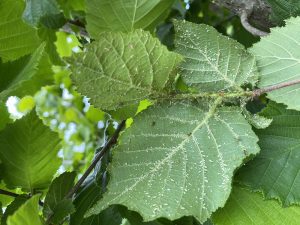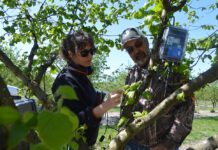
The brown marmorated stink bug (BMSB) can be gumming up aphid control in hazelnuts and is a major concern moving forward, according to Nik Wiman, Oregon State University Extension orchard crops specialist.
The emergence of BMSB in Oregon orchards over the last decade has led some hazelnut growers to increase use of nonselective materials that inadvertently are harming the aphid predator community and the parasitoid wasp Trioxys pallidus, Wiman said.
“Growers have to use a material that is effective against the stink bug, and there is nothing really selective available that they can use that will get both the filbert worm and the brown marmorated stink bug,” he said. “So that means that they have to select usually a pyrethroid to go after the stink bug, which can aggravate the aphid problem.”
The occurrences harken back to a day before the parasitoid wasp was introduced in hazelnuts three decades ago, back when aphids were a considerable problem and required regular treatments, to the point where insecticide resistance developed in the aphid population.
The wasp’s introduction in the 1980s served to dramatically reduce the need for aphid insecticide treatments, Wiman said, and largely kept populations of the filbert aphid under control.
“It is kind of a cool biological control success story,” Wiman said.
Wiman noted, however, he is seeing more aphid pressure in recent years as growers target the stink bug with nonselective materials. And, he said, the increased use of broad-spectrum insecticides and overreliance on neonicotinoids for aphid control raises concerns that resistance issues could once again develop in aphid populations.
“Historically, they had a lot of insecticide resistance in the filbert aphid population, so I’m worried we’re going to see those problems again,” Wiman said.

Crop Damage
Aphids damage hazelnuts in several ways, according to literature. High populations of aphids will reduce kernel fill and nut size, and honeydew produced by aphids can impede photosynthesis and retard growth. Heavy filbert aphid damage to leaves can result in significant orchard defoliation. Further, long-term exposure to aphids can reduce the overall productivity of a tree.
The two aphid species that inflict damage on hazelnut trees have differences that compound control difficulties, Wiman said. And less is known about the hazelnut aphid, which first appeared as a hazelnut pest in the 2000s, than the filbert aphid, which has been a known pest in hazelnuts for as long as the crop has been produced in Oregon.
However, Wiman said, it has long been known the aphid problems are induced by insecticide use against other pests such as filbertworm and BMSB. “One older study that examined the hazelnut pest complex in unsprayed orchards found filbert aphid was not a true pest because the natural enemy complex naturally kept them in check,” he said.
In research backed by the Oregon Hazelnut Commission, Wiman is looking into whether there is a synergistic effect on a tree’s productivity when both aphid species are present. “We don’t really know how to assess the combined effect of those two species acting together when we look at their activity over the course of a field season,” he said.
And there is the question of whether one aphid is more damaging at different times of a season than the other.

“They have different peaks and valleys where they’re really active. So, they may be more or less important at different times of the year. And they also have different natural enemies. I mean, there’s some overlap, but they also have some differences between the two species,” he said.
Also, to date, growers have no way of assessing population levels of hazelnut aphid once the pest works its way from a tree’s leaves to its stems and ultimately husks.
“Early in the season, they’re both on the leaves, and you can use the filbert aphid action threshold to determine whether treatment is warranted,” he said. “But we don’t have a methodology for an action threshold when we have filbert aphids on leaves and hazelnut aphids have moved to the stems and husks.”
In some cases, Wiman said, treatment decisions for aphid are obvious.
“The thing to watch for is the honeydew that they’re producing,” he said. “The leaves tend to get shiny from the honeydew, and you don’t want to see a tree that’s dripping with honeydew because that honeydew will end up getting colonized by the sooty mold fungus, which turns the leaves a dark color and impacts the productivity of the tree by reducing photosynthetic potential.”
In other cases, growers need to weigh the benefits of treatment versus the detriment of removing food for predators. The key, he said, is to tolerate a low to moderate level of aphids in an orchard. “You have to have the aphids as a food source for the natural enemies, and you can’t expect your biological control to wipe out the aphid populations,” he said. “Judicious insecticide use will promote your natural enemies to take care of the problem.”
Stink Bug Sprays
Like with the hazelnut aphid, researchers have yet to develop an action threshold for BMSB in hazelnuts.
“In a four-year study, we did not find a clear relationship between the density of stink bugs on a trap and the amount of crop damage they will inflict,” Wiman said. “So, we are just using the traps as an indicator of presence. But that means a lot of growers don’t have confidence in the traps as a management tool.”
Also like with aphids, there are cases when treatment decisions are made easy for the stink bug, Wiman said.
“Some growers will have thousands of stink bugs overwintering in their outbuildings and on alternative hosts around their farm and so when the spring hits, the bugs go right into the orchard,” Wiman said.
In other cases, decisions are more complex and Wiman is concerned that there are times when growers pull the trigger too quickly.
“A lot of growers just don’t want to take the risk, so they are going to be preventatively applying material, because basically, we haven’t given them the tools they need to be more discriminating with their sprays at this time,” he said. “We need to get better IPM tactics for the stink bug so that we can use sprays against stink bug more judiciously.”
Wiman added concerns over stink bugs are quite valid. “It can be really, really damaging,” he said, noting that packers have recently added stink bug into their insect-damage-sampling protocols.
Wiman said he hopes to provide better answers to questions of whether to spray for the BMSB and has applied for a USDA Specialty Crop Research Initiative grant to develop an action threshold for stink bug based on trap counts and gain a better understanding of risk factors driving stink bug populations in hazelnut orchards.
“That’s where all our big strides have been made is with those national Specialty Crop Research Initiative grant projects. We just tried for a third time under new leadership,” he said in June, noting the last two attempts were unsuccessful. “Hopefully this time we’ll hear a positive result.”
In the meantime, he said, judicious use of insecticides and use of selective materials when possible are two keys to preserving the natural enemies in orchards.










